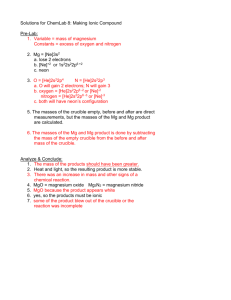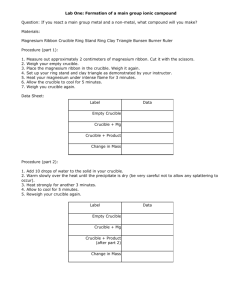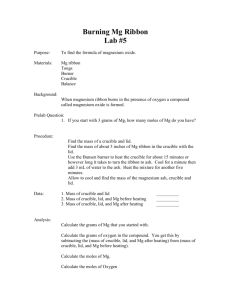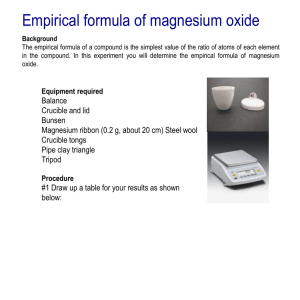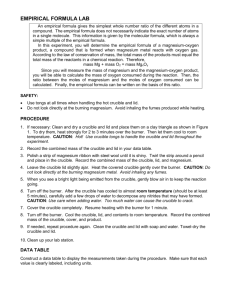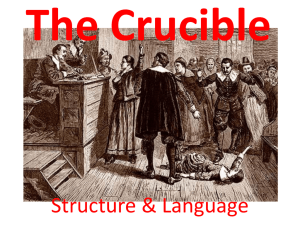docx - Mini
advertisement
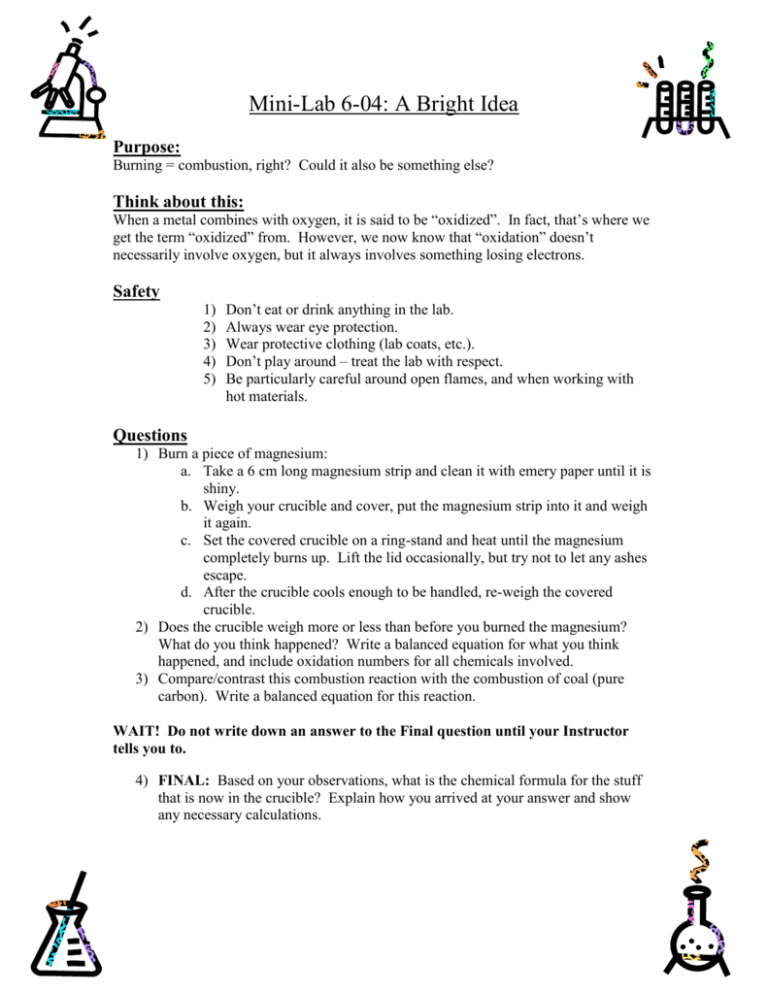
Mini-Lab 6-04: A Bright Idea Purpose: Burning = combustion, right? Could it also be something else? Think about this: When a metal combines with oxygen, it is said to be “oxidized”. In fact, that’s where we get the term “oxidized” from. However, we now know that “oxidation” doesn’t necessarily involve oxygen, but it always involves something losing electrons. Safety 1) 2) 3) 4) 5) Don’t eat or drink anything in the lab. Always wear eye protection. Wear protective clothing (lab coats, etc.). Don’t play around – treat the lab with respect. Be particularly careful around open flames, and when working with hot materials. Questions 1) Burn a piece of magnesium: a. Take a 6 cm long magnesium strip and clean it with emery paper until it is shiny. b. Weigh your crucible and cover, put the magnesium strip into it and weigh it again. c. Set the covered crucible on a ring-stand and heat until the magnesium completely burns up. Lift the lid occasionally, but try not to let any ashes escape. d. After the crucible cools enough to be handled, re-weigh the covered crucible. 2) Does the crucible weigh more or less than before you burned the magnesium? What do you think happened? Write a balanced equation for what you think happened, and include oxidation numbers for all chemicals involved. 3) Compare/contrast this combustion reaction with the combustion of coal (pure carbon). Write a balanced equation for this reaction. WAIT! Do not write down an answer to the Final question until your Instructor tells you to. 4) FINAL: Based on your observations, what is the chemical formula for the stuff that is now in the crucible? Explain how you arrived at your answer and show any necessary calculations. Instructor’s Page 6-04: A Bright Idea Source: Royal Chemistry Society, Classic Chemistry Experiments, #67 Concepts: reduction/oxidation, conservation of mass, chemical formulas Materials: crucible and cover, Bunsen burner, ring stand, iron ring, wire mesh, magnesium strips, emery paper (400 grit sandpaper) Hints: Make sure the students use crucible tongs to handle the hot crucible and cover. Many students will assume that the magnesium will lose mass when it oxidizes. This is because they have an idea in their head that “burning” means losing mass. This is primarily because they have mostly observed the burning of wood and paper, and, of course, the oxide of coal is a gas, so those things lose mass when they “burn”. So, there may be some initial confusion when they realize that the crucible weighs more after the reaction than it did before. That’s a great time to ask, “What do you think happened? What was the magnesium doing when it was burning?” The chemical reaction for this is: Mg(s) + O2(g) MgO2(s) When they answer question 3, they should realize that burning carbon results in a loss of mass only because carbon dioxide is a gas, which is the major “contrast” between the two reactions. Some “comparisons” are that the combustion of coal is also an oxidation/reduction reaction, it also produces heat and light, and it is also spontaneous. Discussion ideas: This is a great practical example of how chemical formulas can be determined. You might discuss the assumptions that are necessary for solving this problem (Law of Multiple Proportions, for example). You might discuss whether the formula they determined is an empirical or molecular formula. You could also discuss the particulars of the oxidation and reduction involved. What if there was no oxygen present? Would the magnesium still burn?

